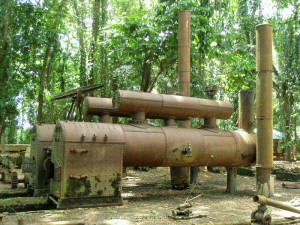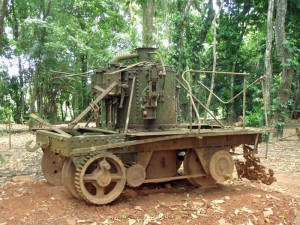Nowadays, it seems like there’s a pill or shot to cure every illness. But do we really know how safe these unnatural remedies are? Throughout my travels and by talking with locals from other cultures, I’ve learned there are many natural treatments that are also effective in promoting good health. For those who’ve ever wondered about the holistic secrets of other cultures, here are some answers.
In Turkey, the trick to staying healthy is mesir paste. The concoction was invented in Manisa during the Ottoman Empire, when the wife of Sultan Yavuz Sultan Selim and mother of Suleyman the Magnificent became very ill. No doctor was able to find a cure, until one created a unique spice blend that seemed to bring the woman back to life. The mixture is a blend of 41 different spices that form a thick paste, and is used as a general cure-all and tonic. Some of the paste’s ingredients include black pepper, cinnamon, licorice root (shown above), coconut and orange peel. The country is so proud of their natural remedy, they celebrate a Mesir Festival in Manisa each year.
 Ukraine
Ukraine
One effective yet simple remedy that can be learned from Ukraine locals is eating a lemon slice – peel and all. Apparently, the zesty flavor of the peel and citrus of the fruit can help aid digestion, reduce bloat and help breathing maladies.
Singapore
According to Cecilia Soh, a Traditional Chinese Medicine Specialist at Singapore’s Eu Yang Sang, Traditional Chinese Medicine (TCM) sees “food as medicine and medicine as food.” Since 74 percent of Singapore’s population is Chinese, TCM is widely used. For example, many Asians will boil chrysanthemum flower tea to clear “excessive yang” from the body. This includes symptoms like sore throat, indigestion, constipation and excessive eye mucus. Peppermint is another herb used as tea that alleviates these symptoms as well as headaches and upper respiratory infections.
 Another common remedy is Perilla leaf (shown right), which helps alleviate seafood-poisoning symptoms. It is often cooked with seafood in order to stop the problem from happening in the first place. For cough, healthy digestion and smooth peristaltic movements, Apricot seeds are used.
Another common remedy is Perilla leaf (shown right), which helps alleviate seafood-poisoning symptoms. It is often cooked with seafood in order to stop the problem from happening in the first place. For cough, healthy digestion and smooth peristaltic movements, Apricot seeds are used.
The most sought after of all holistic medicines, however, is ground up pearl. During ancient times, royal families and wealthy merchants were the only ones who could afford this ancient health and beauty secret. The power can either be ingested or applied to the face for clear skin and anti-inflammation, although a doctor should be consulted before consuming.
 Australia
Australia
The indigenous ingredient used by many Aussie’s to promote health and beauty is not only natural, it’s delicious. Ligurian honey, found in South Australia’s Kangaroo Island, is very rare and powerful. In fact, it is where you can find the only strand of pure Ligurian bees left in the world. When I visited Kangaroo Island, I actually visited the Ligurian honey farm where they sold an array of honey foods, products and treatments. For beauty, the honey contains Vitamin E to help lighten blemishes and promote clear skin. Moreover, in terms of health, pure honey – like the Ligurian variety – is naturally anti-bacterial, and can be used to treat everything from minor wounds and inflammations to ulcers and arthritis.
There are also many natural remedies discovered by the Aboriginals in Australia. Tea tree oil, which is still common today in many parts of the world, is created by crushing up tea tree leaves and either applying the paste to wounds, or drinking as tea for internal ailments. The concoction works wonders and is thought to be more effective than over-the-counter prescriptions. Moreover, washing cuts and wounds with Emu bush leaves has been found to be just as effective as antibiotics, and more natural.
 Aruba
Aruba
In Aruba, there are two very natural remedies used to cure asthma. The first makes use of the aloe plant. Cut a piece, remove the skin, and slurp up the gel. While it may not smell or taste wonderful, it will help your respiratory system and promote good digestion. The other treatment involves boiling gecko lizards, and drinking the hot broth. According to the locals I’ve spoken to, this holistic trick cures asthma permanently.
Bolivia
Because a common problem experienced in Bolivia is altitude sickness, locals use their cash crop of coca leaves to help cure the ailment. You can either chew the leaves, or boil them for tea. Coca leaves are high in calcium and other nutrients, and can also be used to treat illnesses like malaria, asthma, headaches, wounds and even a low sex drive.
 Belize
Belize
According to Joshua Berman, author of Moon Belize, the people of Belize still use many traditional herbs and plants to treat various illnesses, especially the Maya. Travelers can find “medicinal herb trails” throughout the country, and Maya healers are found in the Maya Centre and in some southern villages in the Toledo District.
Herbal medicine, often referred to as bush medicine, is a big part of Belize’s cultural heritage. Plants are used to treat everything from everyday headaches and coughs to more serious ailments like diabetes and infertility. One popular cure for digestive problems and upset stomach is taking allspice tree leaves and making them into a tea. Moreover, the native scoggineal plant is helpful for relieving headaches and fevers by tying it to the forehead. For the common cold or flu, contribo vine can either be made into a tea or soaked in rum. And, if you’ve got itchy or burning skin ailments, like sunburn or bug bites, relaxing in a bath prepared with gumbolimbo bark (shown right) is very helpful.
Colombia
In Colombia, natural remedies are very popular. For instance, using Rosemary by itself will help clear your lungs, while mixing the herb with ginger, half a lemon and honey is a cure for the common cold. If you want improved blood circulation, combine garlic and honey, and if you have swollen eyes you can put manzanilla (camomile) on your eyelids.
 To help alleviate a strong cough, there are two remedies you can borrow from Colombian culture. One treatment is to ingest drops of eucalyptus. The other is placing half a potato near your pillow when you’re sleeping, which will not only help your chest, but will also put you to sleep. Furthermore, for times when digestive problems arise, Colombians will often boil an aloe vera plant (shown right), drink the water, and eat the plant with sugar or honey. Apparently, this cure is very fast acting, although not the greatest tasting.
To help alleviate a strong cough, there are two remedies you can borrow from Colombian culture. One treatment is to ingest drops of eucalyptus. The other is placing half a potato near your pillow when you’re sleeping, which will not only help your chest, but will also put you to sleep. Furthermore, for times when digestive problems arise, Colombians will often boil an aloe vera plant (shown right), drink the water, and eat the plant with sugar or honey. Apparently, this cure is very fast acting, although not the greatest tasting.
Mexico
 In Mexico, holistic healing practices are very common, as there is a lot of indigenous heritage there. Before actual medicine arrived, people used many fruits, vegetables and herbs to cure ailments. One very common natural remedy is eating seedless prickle – the fruit that comes from cacti – for diarrhea. For constipation, papaya and prunes are helpful. If you’ve got a case of conjunctivitis, many locals will make a “chicalote” infusion. This refers to a type of flower with thorny leaves, so you must be careful when picking it. Simply saturate cotton balls with the mixture and dab the eyes. In a few days, the problem will be gone.
In Mexico, holistic healing practices are very common, as there is a lot of indigenous heritage there. Before actual medicine arrived, people used many fruits, vegetables and herbs to cure ailments. One very common natural remedy is eating seedless prickle – the fruit that comes from cacti – for diarrhea. For constipation, papaya and prunes are helpful. If you’ve got a case of conjunctivitis, many locals will make a “chicalote” infusion. This refers to a type of flower with thorny leaves, so you must be careful when picking it. Simply saturate cotton balls with the mixture and dab the eyes. In a few days, the problem will be gone.
 Brazil
Brazil
In Brazil, there are many natural remedies used to treat ailments. First there is açai almond (the actual fruit), which provides a dark green oil commonly used as an anti-diarrheal. Found in Pará in northern Brazil, it is thought to have strong energetic properties. The juice has an exotic flavor and is high in iron – excellent for people with anemia. Guaraná powder is another ingredient that is widely used to help intestinal problems, stop bleeding, relieve headaches and improve brain function. To use it, mash up a guaraná until it turns into a thin, reddish powder. The substance is extremely high in caffeine – four times more than regular coffee. There is also sucupira seed, which contains alkaloids used to help fevers, arthritis and acne. In fact, some pharmacological studies have found the oil from the seeds to be effective against schistosomiasis.
 Morocco
Morocco
In Morocco, where Berber Pharmacies, or herbalists, are popular, many locals seek medical help the holistic way. For example, pavor seeds are used to help soothe nasal congestion. Simply put them in a piece of cloth and knot it to form a ball. Then, place the sack under the clogged nostril while covering the other, and sniff. When having a toothache, Moroccans will put a clove on the tooth that is experiencing pain. These are the dried flower buds of the Myrtaceae family tree (shown).
If dealing with insomnia, one popular holistic remedy is infusing red poppy flower into a tea. And, for fever or itchy eyes, locals will saturate a clean, white cloth with rose water and place it over their eyes or forehead, depending on which ailment they have.
India
In India, it is popular to use turmeric for acne. Grind it into a paste and apply it directly to the skin. You can also do this with sandalwood for the same effect. For an upset stomach, shaved ginger is often put on salads and other foods and ingested. Moreover, congee, or boiled rice with water, is eaten like porridge to promote general wellness.



 Turkey
Turkey








